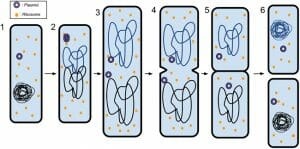Prokaryote Definition
Prokaryotes are unicellular organisms that consist of a single prokaryotic cell. Prokaryotic cells are simple cells that do not have a true nucleus or other cell organelles. Bacteria and Archaea are the two domains of life that are prokaryotes. Prokaryotes can be contrasted with eukaryotes, which have more complex eukaryotic cells with a nucleus and organelles. Eukaryotes are the third domain of life, Eukaryota, and include all complex multicellular organisms such as plants, animals, fungi, and protozoa.
Examples of Prokaryotes
Bacteria
Bacteria are microorganisms that are ubiquitous on Earth. It is estimated that there are 5×1030 bacteria on Earth, which form a larger total biomass than all plants and animals combined. To give an idea of the huge number of bacteria even in small spaces, there are about 40 million bacteria in one gram of soil, and a million bacteria in 1mL of water. Bacteria are diverse and are grouped into many different classifications. There are 28 phyla of bacteria, including Cyanobacteria (blue-green bacteria), Fusobacteria, Acidobacteria, and Proteobacteria, among others.
Bacteria come in many different shapes; they can be Bacilli (rod-shaped), Spirilla (spiral-shaped), Cocci (spherical), comma-shaped, or flagellated. Flagella are small whip-like structures that facilitate movement; bacteria that have flagella may have one, several, or many all over their body. Bacteria can also be classified as being either Gram-positive or Gram-negative; this is based on the results of the Gram staining method. Gram-positive bacteria have thick peptidoglycans in their cell wall that retains violet color from staining, while Gram-negative bacteria appear red or pink because they cannot retain the violet color and only retain the counter-stain.
Some bacteria need oxygen to survive; these are called aerobic bacteria. Bacteria that do not need oxygen are anaerobic bacteria. In addition, bacteria are classified based on how they obtain their nutrition. They may be photoautotrophic, which means they synthesize their food from light and carbon dioxide (like plants do). Others are chemoautotrophic; they produce their own food through chemical sources. Still others are heterotrophic. These bacteria cannot make their own food and need to obtain it from other living things.
Human beings contain many bacteria which enable us to digest food; there are 10 times more bacteria in the gut than there are human cells in the entire human body. Most of the bacteria in the human body are helpful, like gut bacteria, or harmless. However, some bacteria can infect humans and cause diseases such as cholera, syphilis, and tuberculosis.
Archaea
Archaea are single-celled microorganisms that look very similar in size and shape to bacteria. The word archaea comes from the ancient Greek word ἀρχαῖα, which means “ancient things”. They were historically classified as bacteria, but have some characteristics that are more closely related to eukaryotes, such as certain genes and forms of metabolic pathways. Also, they were classified as the third domain of life because they have large differences in their ribosomal RNA structure from bacteria.
Some archaea live in extreme conditions such as hot springs, but others are found in soil, oceans, and even the human body. There are between 18-23 phyla of archaea. Most archaea have never been isolated in the laboratory, and they are only known from their nucleic acids in environmental samples. The cell membranes of archaea differ greatly from all other forms of life, and have molecules found only in archaea.
Evolution of Prokaryotes
Prokaryotes are thought to have been the first forms of life. They arose about 3.5 billion years ago, which is only 1 billion years after the Earth’s crust was formed. However, some scientists believe that prokaryotes may have evolved from eukaryotes and simplified, while others have put forth the theory that prokaryotes and eukaryotes actually evolved at the same time. Eukaryotes appear much later than prokaryotes in the fossil record, about 1.8 billion years after, but they may have evolved earlier.
Prokaryote Reproduction
Prokaryotes evolve through asexual reproduction. The mechanism of reproduction is usually binary fission, which is when one cell splits into two identical cells. It differs from mitosis, the mechanism of cell division in eukaryotes, because it does not involve a spindle apparatus while mitosis does.
This figure depicts binary fission. Step 1 shows the prokaryote cell before the process begins. The DNA is tightly coiled. The DNA then uncoils, duplicates, and splits. A new cell wall is formed in the cell to form two separate cells. These cells then split completely from each other to become two different organisms. Some species can undergo binary fission relatively quickly. For example, the bacteria Escherichia coli, commonly found in the gut, can divide every 20 minutes.
DNA transfer can occur between two bacterial or two archaeal cells, but this is not sexual reproduction. In the process of gene transfer, genetic information is transferred “horizontally” (from one organism to another) rather than “vertically” (from parent to child). Horizontal gene transfer is the mechanism behind drug resistance in bacteria; if one bacterium has a mutation that makes it become resistant, it can spread this gene to other individual bacteria. Eukaryotes can also undergo horizontal gene transfer, but it is much more infrequent.
Related Biology Terms
- Prokaryotic Cell – A cell that has no true nucleus or organelles within.
- Eukaryote – An organism that has eukaryotic cells; this includes protists, plants, animals, and fungi.
- Microorganism – A living thing that is microscopic.
- Horizontal Gene Transfer – Transfer of DNA between organisms that is not from parent to offspring.
Quiz
1. Which is a way that a bacterium can be classified?
A. Whether or not it needs oxygen to survive
B. How it obtains its nutrition
C. Its body shape
D. All of the above
2. How long ago did prokaryotes begin to exist on Earth?
A. 10.5 billion years ago
B. 3.5 billion years ago
C. 1.5 billion years ago
D. 1.5 million years ago
3. Which organism is a prokaryote?
A. Bacterium
B. Fungus
C. Human
D. Oak tree

